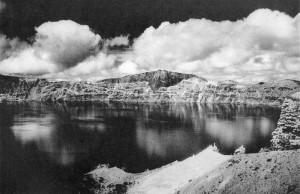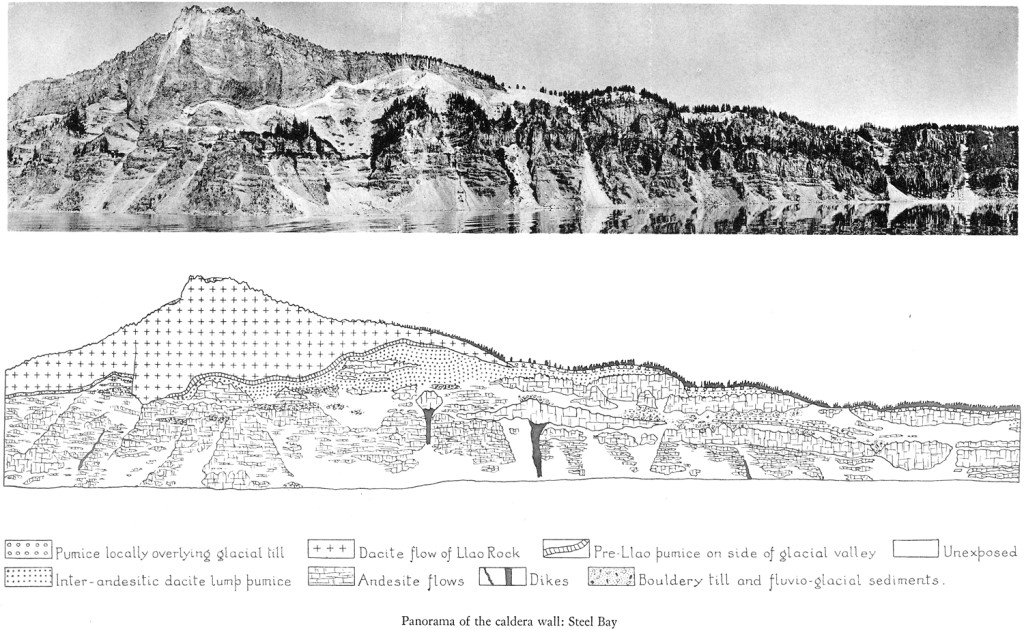The Geology of Crater Lake National Park, OregonWith a reconnaissance of the Cascade Range southward to Mount Shasta by Howell Williams
The Main Andesite Cone of Mount Mazama
Solfataric Areas and Vents
Much of the beauty of the walls of Crater Lake comes from the delicate coloring of the rocks, notably on Garfield Peak and the Eagle Crags and beneath Hillman Peak, where they have been affected by solfataric action. Here the normally somber colors of the andesites give way to shades of yellow, buff , brown, and orange which contrast pleasingly with the deep blue of the adjacent lake and the bright reds of the slaggy lava crusts. Where the lavas have been attacked by rising gases and solutions, they have been reduced to soft, friable masses of brown “earth” composed chiefly of kaolin and opal stained by iron oxides. Elsewhere, they have been bleached to white masses of opal stippled with crystals of pyrite; or, again, the joint faces of the rotted flows may be lined with films of specular hematite and sulphur. Some lavas assume dull-green and brown tints where the ferromagnesian constituents have been converted to chlorite and limonite. In general, the alterations are more pronounced in layers parallel to the banding, so that fresh flows alternate with others which resemble tuff breccias containing unaltered blocks in a rotted matrix. On the western wall of the caldera, discoloration of the lavas increases toward the conduit of the Hillman cone, indicating that decomposition was caused by emanations issuing from that vent. Finally, judging from the occurrence of abundant chips of opalized and thoroughly oxidized lava among the final ejecta of Mount Mazama, the upper, vanished part of the volcano was also the site of many solfataras and fumaroles.
No doubt most of the andesites in the walls of Crater Lake issued from vents near the summit of the mountain. This much follows from their more or less quaquaversal dips. It must not be thought, however, that Mount Mazama was ever a single, symmetrical cone. The walls of the caldera reveal many angular unconformities that cannot be attributed to erosion, but indicate either that the central vents shifted or that several vents were active simultaneously. Angular unconformities related to glacial erosion are easy to recognize, for there is usually a layer of morainic detritus between the unconformable flows. On the other hand, unconformities caused by the activity of shifting or multiple vents are marked by the overlap of one set of flows on the smooth surface of an earlier set. For example, the broad arch of lavas at the base of the caldera wall below Llao Rock, which represents the section of an old cone, is overlapped by a younger arch of lavas the crest of which lies approximately beneath Hillman Peak, and this in turn is partly overlain by the remnant of a third cone which, like the fist, culminates approximately beneath Llao Rock (plate 8). These and similar unconformities suggest that Mount Mazama was a complex of overlapping cones.
|
Plate 8. The west wall of Crater Lake, showing, in addition to the thick dacite flow of Llao Rock, the underlying overlapping arches of lava referred to in the text. (Photograph by William Schoeb.) |
The west wall of Crater Lake, showing, in addition to the thick dacite flow of Llao Rock, the underlying overlapping arches of lava referred to in the text. (Photograph by William Schoeb.)
The symmetry of Mount Mazama was also destroyed by the activity of glaciers. To judge by the great piles of morainic material on the north wall of the caldera, glacial erosion was most intense on that side of the volcano. We find in this a contributory cause for the fact that the north wall of Crater Lake is so much lower than the opposite wall.
On large composite volcanoes, outflow of lava from the summit vents is commonly augmented by eruptions from fissures on the flanks. All the dacite flows of Mount Mazama issued from such lateral fissures. Even before the period of dacitic activity, some of the andesitic flows escaped from vents far below the summit. Three of these vents are perfectly exposed on the walls of Steel Bay (see panorama, plate 28). The youngest is represented by a dike which emerges from the talus about 100 feet above the lake, where it has a width of approximately 15 feet. Upward it thickens gradually, until it suddenly flares into a flow approximately 100 feet thick. An older vent lies a little farther east. Here lava rose through a fissure that widens from 30 feet near the edge of the lake to more than 80 feet about 300 feet higher. At that level the lava escaped from the fissure onto the surface and spread as a wide flow up to 200 feet in thickness. The third and oldest dike-feeder is exposed near the center of Steel Bay, and though it has a maximum width of only 15 feet it fed an extensive flow more than six times as thick.
Plate 28. Panorama of the caldera wall: Steel Bay
Although these are the only lavas traceable to parent fissures, many other thick flows near the caldera rim were probably erupted from lateral openings. Some of these are described in detail in the section dealing with the Northern Arc of Vents.
***previous*** — ***next***



